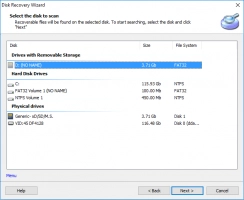Issue: Not enough unallocated space on target disk
In this article you will find out:
- what is Unallocated space
- two ways to convert unallocated space to free space
- how to protect your data
Are you ready? Let's read!
Unallocated space: what is it?
Unallocated space is defined free space on a hard drive or any other external storage device that is not partitioned or usable. That is, you cannot use unallocated space for storage, deletion, editing, etc. data.
Here are some situations when you may be dealing with unallocated space:
- As a result of disk initialization.
- When creating, deleting/shrinking a partition on a disk (the remaining space will be marked as unallocated).
- As a result of damage to the hard disk or external disk.
- As a result of virus attacks.
Two ways to convert unallocated space to free space
Of course, unallocated space is not at all useful for you, since you do not have access to this space. First, you need to convert it to free space, and then use it with full confidence.
Here's what you can do:
1. Create a new section.
2. Add a section to an existing section.
After that, you can save any data you like on the already free disk space.
Method 1: Create a new partition
The easiest way to create a new partition is using Disk Management.
1. Click "This PC" with the right mouse button and select "Manage" from the list.
2. Then select Disk Management and right-click the unallocated space.
3. Now click on "New Simple Volume" and let the Wizard complete this process.
After restarting your computer, you should immediately see that the free space on your computer has increased.
Method 2: Increase an existing partition
You can also enlarge an existing section. This is also done using Disk Management. Go to the section indicated in Method 1 and select the required disk partition with the right mouse button. Then click the “Delete Volume” button, then click “Yes”.
Now select the original partition with the right mouse button and click “Expand Volume”.
In the new window, you will see a Wizard that will help you expand the section as you see fit.
Is unallocated space really useless?
Unallocated space is required when trying to clone a disk, partition, or system. In this case, the system will check if you really have unallocated space. If it is not enough, you will receive the message “there is not enough usable space for this operation” or “not enough unallocated space on the hard drive”. Then you will have to delete the partition and switch to a larger one.
In all other cases, though, unallocated space is more useless than useful.
Hint: use Partition Recovery to protect your data
Disk partitions become inaccessible for various reasons: accidental deletion, numerous bad sectors, power surges, virus attacks, etc. The problem might seem to be irreparable, and you can no longer access the data that was lost. But this is not entirely true: it all depends on the speed of your reaction and on the application you choose to restore the partition.
The faster you start the process of data recovery, the more of a chance you have of returning every single missing file. And the leading application DiskInternals Partition recovery will help you with this.


This program does a deep scan of every disk partition (even those inaccessible to you), and if necessary, converts the file system and brings all the missing files to the surface. You can view all of them for free in reading mode and decide whether to export them or not.
If you do, just buy a license agreement and deal with the recovered files at your discretion.


